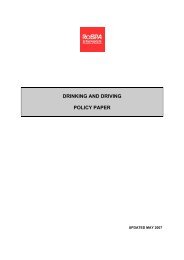RoSPA Young Drivers at Work Report
RoSPA Young Drivers at Work Report
RoSPA Young Drivers at Work Report
You also want an ePaper? Increase the reach of your titles
YUMPU automatically turns print PDFs into web optimized ePapers that Google loves.
Chapter 8<br />
“I introduced a risk assessment for all staff and we<br />
weighted it so th<strong>at</strong> if an individual just had a<br />
driving licence but didn’t have a car of their own<br />
they would be scored differently than someone<br />
who was driving regularly.We ask the question:<br />
have they ever driven abroad? and if the answer<br />
was no then the rule is th<strong>at</strong> they cannot do it<br />
without going with a colleague who is an<br />
experienced driver abroad. Th<strong>at</strong> colleague is<br />
instructed to ease them in gently because you’ve<br />
got to go through the learning process but to do it<br />
in a nice controlled way away from any difficult<br />
navig<strong>at</strong>ion or anything like th<strong>at</strong>. Once someone’s<br />
been through th<strong>at</strong> process two or three times they<br />
will then be able to do th<strong>at</strong> on their own. ”<br />
(Engineering Manager, telephone interviewee)<br />
The driving restrictions put in place by a buddy system are<br />
effectively a form of unofficial gradu<strong>at</strong>ed licensing.<br />
There are a variety of gradu<strong>at</strong>ed processes by which<br />
employers permit their staff to drive solo, and these are<br />
all means of schooling the necessary experience.<br />
Some respondents do not impose limit<strong>at</strong>ions but do<br />
ensure th<strong>at</strong> all new drivers have been through in-house<br />
familiaris<strong>at</strong>ion training with vans and other work vehicles.<br />
The familiaris<strong>at</strong>ion training can involve reversing and<br />
parking and be conducted on-site off the public road.<br />
One organis<strong>at</strong>ion even supplies a training van specifically<br />
to assess employees when they first start driving for them.<br />
Many organis<strong>at</strong>ions said th<strong>at</strong> if their internal assessments<br />
of new drivers are neg<strong>at</strong>ive those employees are subject to<br />
external advanced training, or they are grounded until<br />
further in-house training has been completed. In one case,<br />
a large commercial employer spoke of young drivers being<br />
placed on prob<strong>at</strong>ion:<br />
“As soon as they join the company before they can<br />
drive a vehicle they have to be taken out with an<br />
assessor. If th<strong>at</strong> was unfavourable, I’ve done two so<br />
far and I have to say th<strong>at</strong> yes they had the basic<br />
driving skills, so I have issued them with a driving<br />
permit which has been signed by the oper<strong>at</strong>ions<br />
director. They can then drive under the personal<br />
supervision of an experienced driver for the next<br />
six months and then we’ll review them with<br />
another assessment and by th<strong>at</strong> time we should<br />
also have the training in place. ”<br />
(Training Officer, telephone interviewee)<br />
The company in the above case classified young drivers as<br />
those below the age of 21. The reason for this was th<strong>at</strong> they<br />
run apprenticeship schemes from the ages of 16 and 17<br />
years. In the same way th<strong>at</strong> they would expect apprentices<br />
to build competence in their trade: they expect them to<br />
have gained the relevant experience in driving.<br />
This transference of mechanisms of trade progression<br />
onto driver learning was exemplified in emergency<br />
service training:<br />
“For us to put somebody out as a paramedic, not<br />
just as a practising clinician but as a driver, we<br />
require them to have a prob<strong>at</strong>ionary period and<br />
during th<strong>at</strong> prob<strong>at</strong>ionary period the driving is<br />
assessed as well as their clinical skills. I think th<strong>at</strong><br />
should be a standard for young drivers, there<br />
should be some kind of prob<strong>at</strong>ionary period. ”<br />
(Manager, telephone interviewee)<br />
Although not yet taken up by any organis<strong>at</strong>ion in our<br />
sample, respondents suggested the use of driving<br />
simul<strong>at</strong>ors for supplementing young peoples’ experience.<br />
Some members of the focus groups discussed simul<strong>at</strong>ors<br />
they had experienced in school:<br />
“Simul<strong>at</strong>ors would probably be a good idea because<br />
you could do hazard awareness and build hazards<br />
into the simul<strong>at</strong>or. I think th<strong>at</strong>’s a good one to do<br />
because you’re driving along and all of a sudden<br />
somebody steps out in front of you and you’re<br />
never going to get th<strong>at</strong> reaction out on the road.<br />
It needs to be something th<strong>at</strong> people can<br />
experience without the actual consequences. ”<br />
(Company Director, telephone interviewee)<br />
“Some people are really good <strong>at</strong> exams, some people<br />
are really good <strong>at</strong> the practical stuff but <strong>at</strong> the end<br />
of the day everyone’s going to be doing the<br />
practical day in, day out, so why not do a simul<strong>at</strong>or<br />
test? Cut out the written part because if somebody<br />
comes to a junction and doesn’t know wh<strong>at</strong> to do,<br />
th<strong>at</strong> won’t be apparent on a written test whereas<br />
it will be obvious in a practical, but if you do th<strong>at</strong><br />
in real life they could cause accidents so I believe<br />
in simul<strong>at</strong>ion. ”<br />
(Focus group 4 member)<br />
36 <strong>Young</strong> <strong>Drivers</strong> <strong>at</strong> <strong>Work</strong> <strong>Report</strong>
















